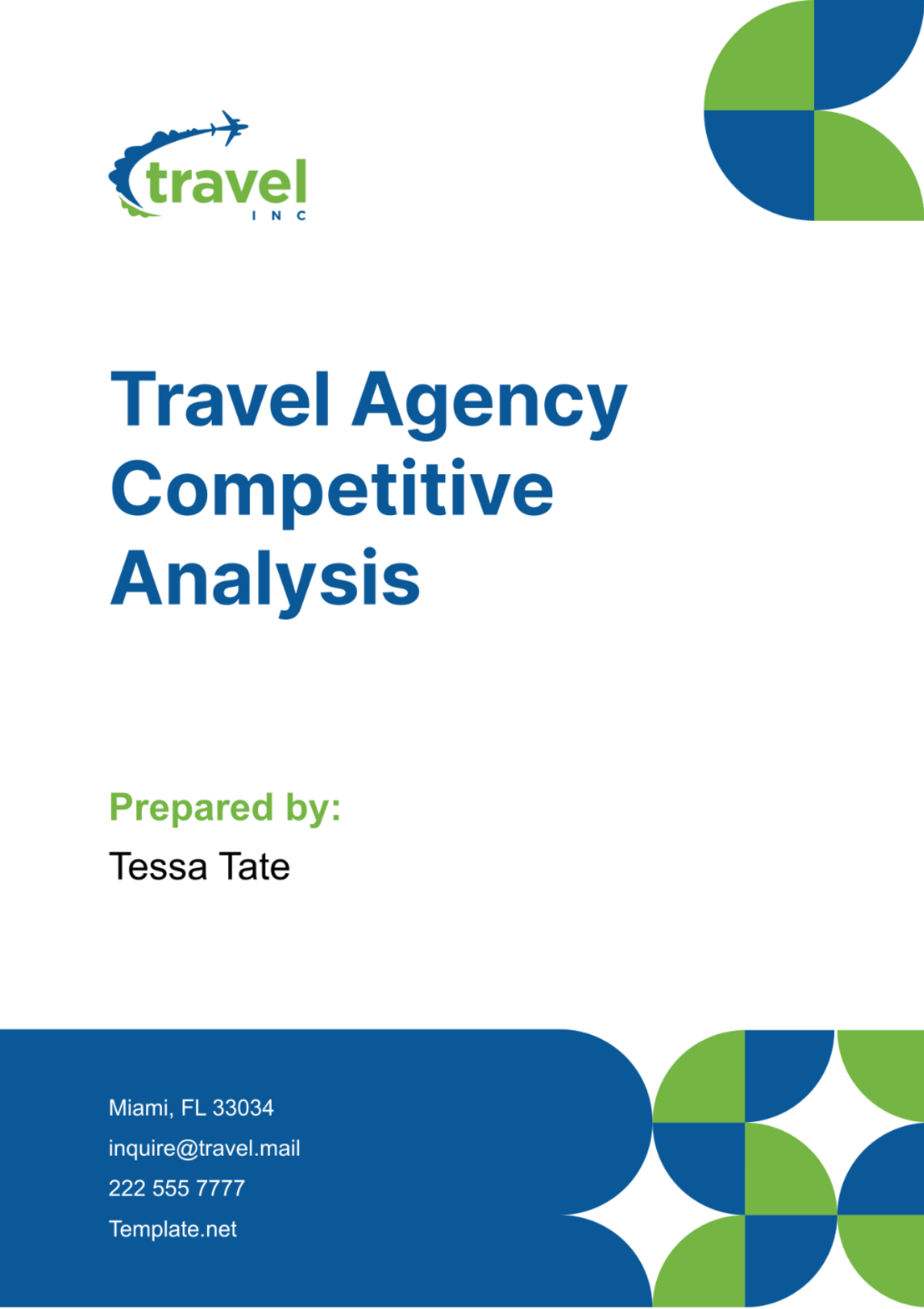Free Travel Agency Competitive Analysis

I. Introduction
In an ever-evolving travel industry marked by shifting consumer preferences and technological advancements, gaining a comprehensive understanding of the competitive landscape is imperative for our travel agency's strategic planning and market positioning. This competitive analysis aims to delve deeply into the strategies, strengths, weaknesses, opportunities, and threats posed by key competitors in the travel sector. By conducting a thorough assessment of our competitors, we can identify areas for differentiation, capitalize on market trends, and devise strategies to enhance our competitive advantage.
II. Competitor Identification
A. Direct Competitors
Competitor Name | Overview | Unique Selling Proposition |
|---|---|---|
[Competitor A] | Established in 1990, renowned for premium travel experiences and luxury partnerships. | Offers bespoke vacation packages, personalized service, and exclusive access to luxury resorts and tour operators. |
[Competitor B] | Founded in 2015, a leading online travel agency known for competitive pricing and user-friendly platform. | Provides budget-friendly options, last-minute deals, and dynamic pricing for affordability-conscious travelers. |
[Competitor C] | Specializes in adventure tourism and sustainable travel experiences since 2008. | Focuses on eco-friendly practices, immersive cultural experiences, and guided expeditions to remote destinations. |
B. Indirect Competitors
Competitor Category | Overview | Competitive Factors |
|---|---|---|
Airline Companies | Major airlines such as Delta, Emirates, and Singapore Airlines offer direct booking services and vacation packages. | Provide loyalty programs, frequent flyer perks, and bundled deals. |
Hotel Chains | International hotel chains like Marriott, Hilton, and IHG provide booking platforms and loyalty programs. | Extensive property portfolios, global brand recognition, and exclusive guest benefits. |
Tourism Boards | Promote tourism through destination marketing campaigns, cultural events, and travel incentives. | Showcase attractions, local experiences, and provide travel resources. |
III. Service Offerings
[Competitor A]: Offers comprehensive vacation packages that include flights, accommodations, guided tours, and transportation services. They emphasize personalized travel experiences tailored to the preferences of their customers.
[Competitor B]: Focuses on providing budget-friendly options for travelers, offering discounted flight and hotel bookings, as well as last-minute deals.
[Competitor C]: Specializes in adventure tourism, offering hiking, trekking, and wildlife safaris in remote destinations. They prioritize sustainable and eco-friendly travel experiences.
IV. Pricing Strategy
[Competitor A]: Adopts a premium pricing strategy, positioning themselves as a provider of high-quality travel experiences with personalized services. They offer competitive prices for their packages, targeting affluent travelers.
[Competitor B]: Differentiates itself through competitive pricing, offering discounts and promotions to attract price-sensitive customers. Their dynamic pricing model adjusts prices based on demand and availability.
[Competitor C]: Focuses on value-based pricing, charging premium rates for unique adventure experiences and eco-friendly travel initiatives.
V. Customer Segmentation
[Competitor A]: Targets affluent travelers seeking luxury vacations, honeymooners, and family travelers looking for customized experiences.
[Competitor B]: Caters to budget-conscious travelers, including millennials, backpackers, and spontaneous travelers seeking affordable options.
[Competitor C]: Appeals to adventure enthusiasts, eco-conscious travelers, and niche market segments interested in sustainable tourism and immersive cultural experiences.
VI. Marketing and Branding
[Competitor A]: Maintains a strong brand presence through traditional advertising channels, social media engagement, and partnerships with luxury resorts and airlines. Their marketing messages emphasize luxury, exclusivity, and personalized service.
[Competitor B]: Relies heavily on digital marketing, leveraging SEO, PPC advertising, and social media campaigns to reach a wide audience of budget travelers. Their branding emphasizes affordability, convenience, and accessibility.
[Competitor C]: Focuses on niche marketing, targeting specific interest groups through specialized travel blogs, eco-friendly initiatives, and partnerships with environmental organizations. Their branding emphasizes sustainability, adventure, and cultural immersion.
VII. Distribution Channels
[Competitor A]: Utilizes a combination of online and offline distribution channels, including their website, mobile app, physical offices, and partnerships with travel agents and tour operators. This multi-channel approach ensures accessibility and convenience for customers while also leveraging the expertise of travel professionals.
[Competitor B]: Operates primarily through its online platform, offering a user-friendly booking interface accessible via desktop and mobile devices. They also partner with affiliate websites and travel aggregators to expand their reach and tap into new customer segments.
[Competitor C]: Emphasizes direct bookings through their website and mobile app, providing a seamless and intuitive booking experience for customers. Additionally, they collaborate with eco-conscious travel agencies and adventure tour operators to reach niche markets and promote their sustainable travel initiatives.
VIII. Customer Experience
[Competitor A]: Provides personalized assistance throughout the booking process, with dedicated travel advisors available to answer queries and tailor itineraries to customers' preferences. They offer 24/7 customer support and post-travel assistance to ensure a seamless experience, building trust and loyalty among their clientele.
[Competitor B]: Offers a streamlined booking process with instant confirmation and online support services. However, their customer service may lack the personal touch compared to traditional travel agencies, relying on chatbots and automated responses to address customer inquiries.
[Competitor C]: Focuses on delivering authentic and immersive travel experiences, with knowledgeable guides and sustainable practices. While their customer service may be limited in remote destinations, they prioritize customer satisfaction and engagement, fostering long-term relationships with their eco-conscious clientele.
IX. Technology and Innovation
[Competitor A]: Leverages technology to enhance customer engagement, offering virtual tours, augmented reality experiences, and personalized recommendations based on customer preferences. They invest in CRM systems and data analytics to understand customer behavior and tailor marketing efforts accordingly, staying ahead of evolving consumer trends.
[Competitor B]: Invests in cutting-edge booking technology, including AI-powered chatbots, predictive analytics, and dynamic pricing algorithms to optimize the booking process and improve user experience. By harnessing the power of data and automation, they streamline operations and deliver personalized recommendations to customers, driving conversion and loyalty.
[Competitor C]: Explores innovative solutions such as virtual reality (VR) travel experiences, carbon offset programs, and community-based tourism initiatives to differentiate their offerings and appeal to eco-conscious travelers. By embracing sustainable practices and leveraging technology for environmental conservation, they position themselves as industry leaders in responsible tourism.
X. Strengths and Weaknesses
A. Strengths
[Competitor A]: Strong brand reputation, personalized service, and extensive network of luxury partners.
[Competitor B]: Competitive pricing, user-friendly booking platform, and wide reach.
[Competitor C]: Niche market positioning, focus on sustainability, and unique adventure offerings.
B. Weaknesses
[Competitor A]: Higher pricing may limit accessibility to budget travelers.
[Competitor B]: Reliance on digital channels may limit personalization and customer engagement.
[Competitor C]: Limited geographical coverage and dependency on niche market segments.
XI. Opportunities and Threats
A. Opportunities
Market Expansion: Expanding into emerging markets or underserved demographics presents opportunities for growth, such as catering to solo travelers, LGBTQ+ travelers, or seniors.
Partnership Collaborations: Forming strategic partnerships with airlines, hotels, or local tourism boards can enhance our offerings and reach new customer segments.
Technology Integration: Embracing innovative technologies like artificial intelligence (AI), virtual reality (VR), and blockchain can streamline operations and enhance the customer experience.
Sustainability Focus: Capitalizing on the growing demand for sustainable travel by promoting eco-friendly initiatives, carbon offset programs, and responsible tourism practices.
B. Threats
Online Disintermediation: Increasing competition from online travel agencies and direct booking platforms may pose a threat to traditional travel agencies, leading to margin pressures and reduced market share.
Economic Instability: Economic downturns, currency fluctuations, and geopolitical tensions can impact consumer spending on travel, affecting demand for our services.
Regulatory Changes: Changes in government regulations, visa policies, or travel restrictions may disrupt our operations and limit our ability to offer certain destinations or services.
Technological Disruption: Rapid advancements in technology and the rise of disruptive startups could challenge our market position and force us to adapt to changing consumer preferences and behaviors.
XII. Conclusion
In conclusion, this competitive analysis has provided valuable insights into the strengths, weaknesses, opportunities, and threats present in the travel industry. By leveraging our strengths, addressing our weaknesses, and capitalizing on emerging opportunities, we can enhance our competitive position and drive sustainable growth in the market. By remaining agile, innovative, and customer-centric, we can navigate the challenges and uncertainties ahead while continuing to deliver exceptional travel experiences to our valued customers.
- 100% Customizable, free editor
- Access 1 Million+ Templates, photo’s & graphics
- Download or share as a template
- Click and replace photos, graphics, text, backgrounds
- Resize, crop, AI write & more
- Access advanced editor
Deliver comprehensive insights with the Travel Agency Competitive Analysis Template from Template.net. This editable and customizable template equips you with the tools to analyze competitors' strategies, strengths, and weaknesses. Utilize the AI Editor Tool to tailor the analysis to your agency's needs and gain a competitive edge in the dynamic travel industry.





























